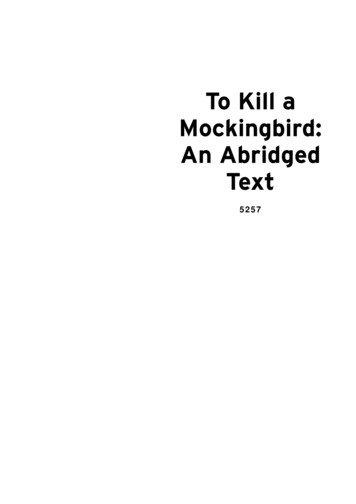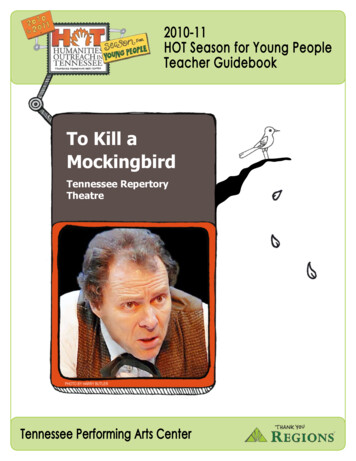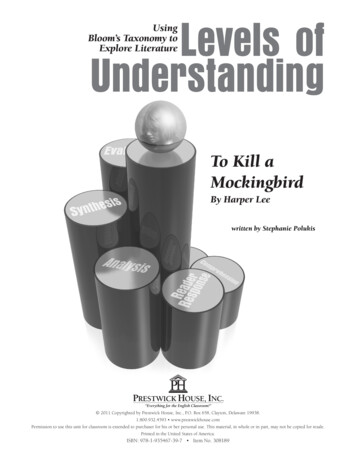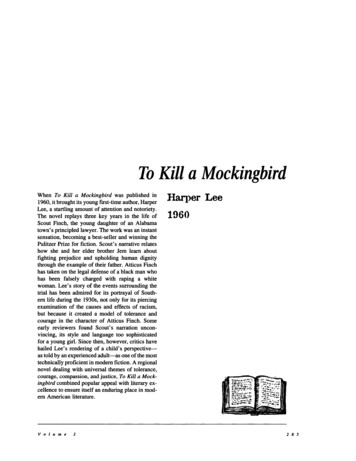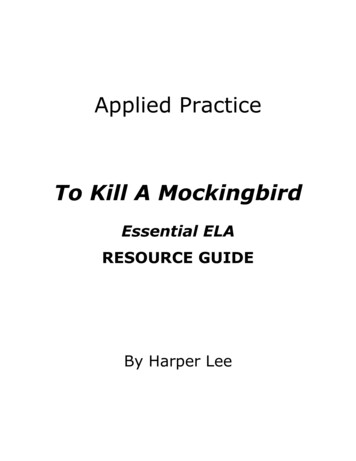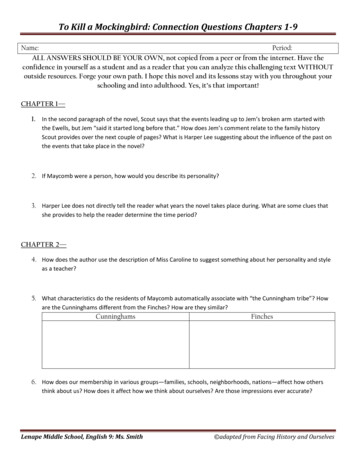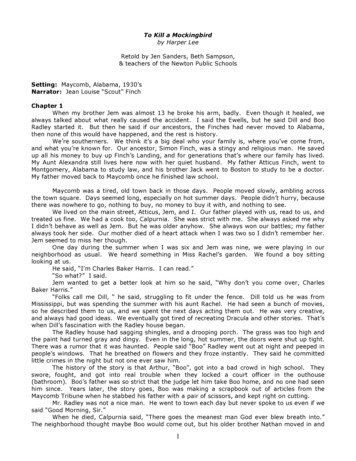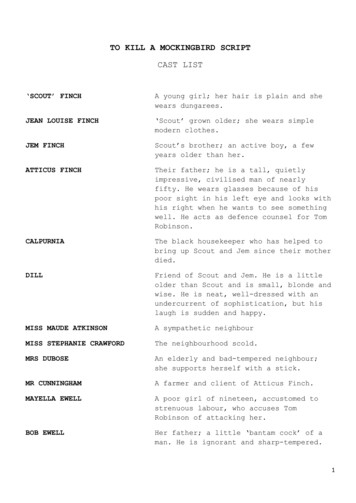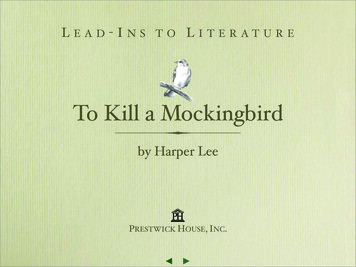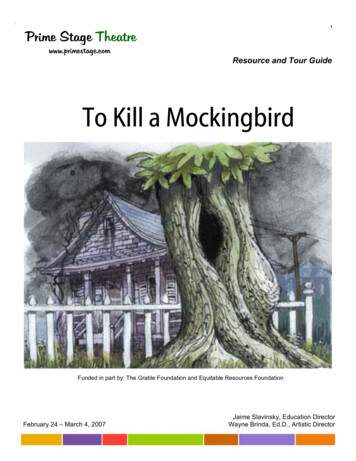
Transcription
e1Prime Stage Theatrewww.primestage.comResource and Tour GuideTo Kill a MockingbirdFunded in part by: The Grable Foundation and Equitable Resources FoundationFebruary 24 – March 4, 2007Jaime Slavinsky, Education DirectorWayne Brinda, Ed.D., Artistic Director
e2Prime Stage Theatrewww.primestage.comResource and Tour GuideIntroduction & How to Use this GuideThis guide was based on continual research conducted by the Prime Stage Artistic Director on reluctant andstruggling readers and the results of a study Prime Stage conducted with students and teachers from twoschools that explored how to “Connect kids to literary classics” through the theatre and in the classroom. Thestudy’s participants made four significant recommendations:- Provide resources that help students connect the literature, the play, and their lives.- Provide resources that help teachers create engaging and enriching experiences.- Change the name of the curriculum or study guide to a “Resource and Tour Guide.”- Introduce the world of the literature and the world of the play to help students and teachersadequately prepare for the experience of seeing literature come to life on stage.Reluctant & Struggling Readers – Much research is conducted on students designated as reluctant andstruggling readers. There are many websites devoted to this subject; Links to some of these can be found on theeducation pages of our website. In summary, reluctant readers want choice, help navigating through complexliterature, and experiences to share their responses with peers and adults (Baker 2002; Gambrell 1996; Ivey2002; Reeves 2004; Sumara 2002; Tovani 2000). Struggling readers need support with vocabulary, “chunking”ideas rather than decoding words, visualizing, expressing what they see, and how to ask questions as they read.This guide addresses those concerns by providing a range of information that reluctant readers can choose toexplore, read, and discuss as they discover To Kill a Mockingbird. For struggling readers, complex or unfamiliarvocabulary is highlighted to help you create “word walls” or other strategies that address comprehension and,ultimately, enjoyment of the literature.Visualization, Imagery & Imagination – Wilhelm (2004), in Reading is Seeing, proposed addressingvisualization can: Heighten motivation, engagement, and enjoyment of reading.Enhance comprehension of both narrative and expository texts.Stimulate prior knowledge.Provide a “template” for more sophisticated strategies, such as inferring.Develop awareness of one’s reading processes (metacognition).Increase reader’s ability to share, critique, and revise what is learned with others.Discover aesthetic appreciation of text.Improve test scores.Imagery - Recreating in one's mind the sights, sounds, smells, tastes, and touches described by an author(Clewell 2006). Pictures in this guide can help your students visualize and describe what they read and see.How to use this guideThis guide is not a collection of lesson plans. While you will find lesson suggestions throughout the guide, thematerial is designed to provide material that will enrich your lessons with students, encourage them to read theliterature, improve their vocabulary with words highlighted in bold that may be unfamiliar to them, andcomprehension of the literature, and stimulate an enjoyment of reading and exploring literature.This guide is designed to help you find ways of helping your students see the literature, not just as words onpages, but as vibrant images, characters, settings, conflicts, and ideas that relate to their lives today.We hope you find this Resource and Tour Guide useful, helpful, and enjoyable.Thank you.
e3Prime Stage Theatrewww.primestage.comResource and Tour GuideContentsBackground on the book and the play1. Profile of author, Harper Lee.2. Definition of Pulitzer Prize for Literature.Tour of the book and resources1. The title.2. The location.3. The American South in the 1930’s and The Scottsboro Boys.Mary Badham, as Scout inthe film.* She is leading theTeacher Workshopon March 3, 2007!The 1930’s world of Scout, Jem, Dill and Atticus1. Two interesting websites.How the play will bring the literature to life1. Profiles of the Director and Set Designer of the stage adaptation.2. Setting.3. Actors in the production.4. The adaptation.5. Language and dialect.What audiences need to do in the theatre1. Theatre etiquette.Additional information on the book, the play, reluctant readers,supplemental literature and Prime Stage1. Allusions in the novel and the script.2. Idioms in the novel and the script.3. Suggested websites.4. Carnegie Library suggested books.5. Websites on reluctant readers.6. Mission and vision of Prime Stage.Feedback form for teachers to send comments and suggestions“To Kill a Mockingbird is a sensitive look into the lives of a single-parent familyheaded by a father who is kind, loving, and sensitive but firm. Looking at lifethrough the eyes of children at simpler times, leaves us hopeful for the future.”- Mary Badham“Scout” in the award winning film To Kill a Mockingbird.
e4Prime Stage Theatrewww.primestage.comResource and Tour GuideBackground on the Book and the PlayWho wrote the book?PROFILE OF AUTHOR - HARPER LEEMs. Lee commenting on her novel’s enormous successInterview with Roy Newquist,1964“I didn’t expect any sort of success with Mockingbird . . . I washoping for a quick and merciful death at the hands of reviews, but atthe same time I sort of hoped for a little, as I said, but I got rather awhole lot and in some ways this was just as frightening as the quickmerciful death I’d expected.”Harper Lee as a young writer.In Oprah Winfrey’s literary magazine, June 2006“Now, 75 years later in an abundant society where people havelaptops, cell phone, iPods and minds like empty rooms, I still plodalong with books.”Harper Lee’s essay, “Romance and High Adventure”, can be found inClearings in the Thicket: An Alabama Humanities Reader, ed. JerryElijah Brown (Mercer University Press, Georgia, 2006)Shields, Charles J: Mockingbird: A Portrait of Harper Lee (Henry Holt &Co., New York, NY)Harper Lee today.
e5Prime Stage Theatrewww.primestage.comResource and Tour GuideTimeline of Harper Lee and To Kill a MockingbirdWhat events do you see that are similar to events in the book?1924Truman Capote, life-time friend of Ms. Lee and inspiration for Dill wasborn in New Orleans.1926Nelle Harper Lee was born on April 28th in Monroeville, which ismidway between Montgomery and Mobile in southwest Alabama. Shewas the youngest of four children born to mother, Frances CunninghamFinch Lee and father, Amasa Coleman Lee, a leading attorney. She hadtwo sisters, Alice and Louise, and a brother, Edwin. Harper Lee was atomboy, and several reminiscences published by former schoolmatesin the Monroe Journal testify to her playground ferocity.1929Martin Luther King, Jr. born in Atlanta, Georgia.1929 - 1939The Great Depression in the United States and the world.1931The Scottsboro Incident (information found in this Resource Guide).1939 - 1945World War II.1945 - 1959Lee studied law at the University of Alabama, and wrote for severalstudent publications. Editor of the campus humorous magazine,Rammer-Jammer. Her final year was an exchange year at OxfordUniversity, but she left a semester before completing her degree.1950’sLee moved to New York and worked as a reservation clerk with EasternAir Lines and BOAC. She had written a number of short stories.1952Mary Badham born in Birmingham, Alabama.1957The original manuscript of To Kill a Mockingbird was submitted to theLippincott publishing company as a series of short stories. Editor, TayHohoff, helped her rewrite it. They worked on it for two and a half years.1959Lee traveled to Kansas with lifelong friend Truman Capote to helpresearch his non-fiction book, In Cold Blood.1960To Kill a Mockingbird published. Its timing coincided with stirrings of theCivil Rights Movement and became identified with the cause.1961To Kill a Mockingbird won the Pulitzer Prize for Fiction. An article –Love: In Other Words, was published in Vogue magazine. Anotherarticle, Christmas to Me, was published in McCall’s magazine.Dill inMockingbirdMartin LutherKing, Jr.Mary Badham &Gregory Peck
e6Prime Stage Theatrewww.primestage.comResource and Tour GuideTimeline of Harper Lee and To Kill a Mockingbird (continued)1962To Kill a Mockingbird became a triple-Oscar winning film starringGregory Peck as Atticus Finch and Mary Badham as Scout.Harper Lee declined to write the screenplay, so Horton Foote wrote thescreenplay.1963Pres, John Fitzgerald Kennedy assassinated in Dallas, Texas.1964The Civil Rights Act passed by United States Congress.1968Martin Luther King, Jr. assassinated in Memphis, Tennessee.1990An honorary doctorate degree was presented to Harper Lee by theUniversity of Alabama.1997Another honorary doctorate, of humane letters, was presented by SpringHill College in Mobile, Alabama.2005Lee accepted the Los Angeles Public Library Literary Award.2006Awarded another honorary degree by the University of Notre Dame.2007Harper Lee now lives principally in Monroeville, Alabama where sheshares a home with her elder sister, Alice, who, at the age of 94, is still apracticing lawyer.The Pulitzer Prize is named for Joseph Pulitzer, an Hungarian-born, intense figure, Pulitzer was the mostskillful of newspaper publishers, a passionate crusader against dishonest government, a fierce, hawk-likecompetitor who did not shrink from sensationalism in circulation struggles, and a visionary who richly endowed hisprofession. A Pulitzer Prize is the highest national honor given in print journalism, literary achievements, andmusical compositions. It is administered by Columbia University in New York City. Visit http://www.pulitzer.org/ formore information that would appeal to your students.Lesson Suggestion - For more information on Harper Lee, including complete transcripts of interviews and aninteresting look at Monroeville, Alabama, I suggest you and your students visit the following website –Harper Lee Interviews at iews.html
e7Prime Stage Theatrewww.primestage.comResource and Tour GuideTour of the Book and ResourcesDid you know?MockingbirdThe TitleAtticus Finch tells his children: “Shoot at all the blue jays you want, if youcan hit ‘em, but remember it’s a sin to kill a mockingbird . . . becausemockingbirds don’t do one thing but . sing their hearts out for us. That’swhy it’s a sin to kill a mockingbird.”The mockingbird is a potent symbol of innocence which can be destroyedby evil, and it is a motif which is repeated several times in the story.The Mockingbird is the symbolof Texas. Native to America, itis a member of the familyMimidae, has grey plumageand a grey tail, and is noted forits ability to mimic the songs ofother birds.In the play as well as the novel, many characters may symbolize amockingbird. Tom Robinson is the most obvious example, but there areothers such as Arthur ‘Boo’ Radley, whose life has been blighted bycruelty and evil, but who is spared an even greater evil by the humanity ofSheriff Tate.At the end of the play, Scout tells her father, “What Heck Tate said aboutBoo — about dragging him into the limelight — Heck was right . I mean,it’d be sort of like shooting a mockingbird, wouldn’t it?”Lesson Suggestion - Connections of the Literature to LifeWho else in the story and in your community would be mockingbirds?Who do you know that has the courage to stand up for an unpopularcause or a person who has been wrongfully accused of something?Maycomb CourthouseBesides To Kill a Mockingbird, what could be a good title of the book?Explain your choice.Atticus is a widower, and a single parent of two children. How do theinterests, lives, and curiosities of Jem and Scout Finch compare to yourlife or the lives of your friends?What things do Jem, Scout, and Dill do during their free time? How dotheir activities compare to your interests?The actual Maycomb Countycourtroom was used in thefilm.Boo Radley’s house is a place of mystery, suspicion, and myth. Whatplace in your neighborhood is similar to Boo’s house? Discuss themysteries, suspicions, and myths of that place and write a story aboutwhat could happen in your neighborhood with the house.
e8Prime Stage Theatrewww.primestage.comResource and Tour GuideThe LocationHere are several bits of information to compare Maycomb to your town.Lesson suggestions - Explore what kind of town is Maycomb, Alabama? Pull out images that are veryclear at the beginning of the book that paint a picture of the town and the time period? Explore images thatmay be confusing to the students. What images of the town are different from what you see in yourneighborhood? Write a journal that describes your students’ neighborhoods like Lee does with the book.How does Lee create vivid pictures of the place and time in which her story is set? What details about thetown, its history and its inhabitants, make the place feel real? Why is the setting important for the story?How would the story be different if it were set in New York City, Miami, Los Angeles, or Pittsburgh? Whatare the differences between Monroeville, Alabama and Monroeville near Pittsburgh?Monroeville, Alabama"Literary Capital of Alabama"Monroeville is a city in Monroe County. It is the county seat.The community was named for Monroe County, which was named forPresident James MonroeHarper Lee's "To Kill a Mockingbird" is performed each May at theOld Monroe County CourthouseRent in Monroeville, at the time of the 2000 Census, was 244. Monthlyhomeowner costs, for people with mortgages, were 813.The estimated population, in 2003, was 6,748.Well-known residents have included:Truman Capote, authorMark Childress, novelistHarper Lee, authorMarie Rudisill, known as "The Fruitcake Lady" on NBC's Tonight ShowWilliam Barret Travis, commander of Texans at the AlamoCrimeThe number of violent crimes recorded by the FBI in 2003 was 101.The number of murders and homicides was 0. The violent crime rate was 14.8 per 1,000 people.EconomyAt the time of the 2000 census, the per capita income in Monroeville, AL was 17,070, compared with 21,587 nationally. About 20.4% of families and 23.0% of the population were below the poverty line,including 29.0% of those under age 18 and 19.2% of those who are 65 or over.
e9Prime Stage Theatrewww.primestage.comResource and Tour GuideThe American South in the 1930’sWhile the British were in control of the Colonies, before the Revolutionary War,they realized that their colony needed many more hands than were availableamong the settlers. So, they filled the deficit by resorting to the time-honoredresource of the slave trade.The Colonists and British were not unique in this. All countries with ambitions ofexpansion had exploited it, including Spain, Portugal, Denmark, the Netherlandsand France. The Ancient Romans gave the trade its name. The word ‘slave’originated in the Slavs, or Slavi, tribe who inhabited the banks of the DnieperRiver in the Western Soviet Union. During the latter days of the Roman Empire,they were routinely captured and dispersed throughout Europe.Slaves almost all came from West African coastal states, and half a million weretaken to America to tend the huge plantations and work in the mines.When Abraham Lincoln was elected President on a platform which opposed theextension of slavery, revolt beckoned. Seven southern states seceded from theUnion, declared themselves the Confederate States of America, and electedtheir own President, Jefferson Davis. The Vice-President of the Confederacy,Alexander Stephens, said that the constitution of the new government of thesouthern states was founded “upon the great truth that the Negro is not equal tothe white man; that slavery — subordination to the superior race — is his naturaland normal condition. This, our new government, is the first in the history of theworld based upon this great physical, philosophical, and moral truth”.Other southern states soon rallied to the cry. The issue divided the nation. Theissue became a significant cause of the American Civil War of 1861-1865, whichdivided families as some members fought on different sides.President Lincoln was true to his electoral pledge, and the victorious Unionabolished slavery in the US in 1872. However, the south remained divided, andbecame the cradle of overtly racist organizations advocating white supremacy, andresorting to criminal, terrorist tactics to promote their dogma, such as the Ku KluxKlan.The Alabama into which Harper Lee was born was steeped in bigotry, lynch law was still prevalent, and noblack person could expect to be treated as an equal of her/his white kin, particularly if they came up againstwhite man’s law. There is no clearer demonstration of this than the notorious miscarriage of justiceimmortalized as The Trials of the Scottsboro Boys. This case was an inspiration for To Kill a Mockingbird,as it dragged on for six years, and would have been well known, and discussed, in the legally conscious Leehousehold.It may also have been an embarrassment to the liberal Lee family, that the renowned General Robert E. Lee,who led the Confederate army in Virginia between 1863 and 1865, was an ancestor of Harper Lee’s father,Amasa!
e10Prime Stage Theatrewww.primestage.comResource and Tour GuideThe Scottsboro Boys‘Hoboeing’ i.e. hitching free rides on freight trains, was popular amongthe unemployed and poor in America during the Depression years. Theyused this means to travel around the country in a usually fruitless huntfor jobs.On one such train, on March 25, 1931, were a couple of dozen youngpeople, among them four black teenagers from Chattanooga, and fiveothers from various parts of Georgia. They had heard of possiblelogging work in Memphis.Traveling with them were four young white people, including two girls dressed in overalls, who were returningfrom an unsuccessful job search in Chattanooga. During the journey, one of the white youths, while walkingacross the top of the cars, accidentally stepped on the hand of a black youth who was holding on to the side.A fight broke out between the two groups and the black youths managed to force all but one of the whiteyouths off the train. The enraged evictees found a stationmaster, reported the incident as an assault. Hewired the news ahead. The train was stopped by an armed Sheriff’s posse at Paint Rock, Alabama, and allnine black youths aboard were rounded up, bound, and loaded onto a truck to be taken to jail in Scottsboro.The two overall-clad girls on the train, Victoria Price and Ruby Bates, were questioned bythe posse and claimed that they had been raped by a dozen blacks wielding knives andguns. They were taken to the jail, where Price identified six of the Scottsboro Boys as herassailants. A lynch mob of several hundred people gathered outside, but was thwartedin their murderous mission when the State Governor sent in the National Guard.There were suspicions right at the start that the supposed ‘crime’ had not actuallyoccurred at all. The two women destined to be the main prosecution witnesses had notbeen seeking work in Chattanooga as they claimed but had traversed state lines for‘immoral purposes’ and then lied to the lawmen to deflect attention from this (prostitutionwould have been a violation of the Mann Act and would earn them prisonsentences). Victoria Price was known to be the local town prostitute, and Ruby Bates’Ruby Batesmorals were also questionable.The first Scottsboro trial began twelve days after the arrest of the boys and had all the elements of farce. Thetwo lawyers representing the boys were a real estate attorney who had never advocated in a criminalcourt, and who was drunk throughout the proceedings, and an absent-minded 70-year-old whose career hadbeen moribund for decades. This ‘defense’ team was happy to agree to having all nine defendants triedtogether, despite this being prejudicial to all of them, and particularly to the two who were twelve andthirteen years old at the time. Even the prosecution realized this procedure was possibly unfair, or at leastmight lead to a mistrial. They arranged (and the ‘defense’ agreed) that the boys would be tried in groups oftwo or three.An enormous hostile crowd gathered outside the courthouse. When the verdict of ‘guilty’ in the first trial wasannounced, they roared their approval. As the second trial was already in progress this was heard by the juryinside. By the end of the trials, eight of the nine Scottsboro boys had been sentenced to death.
e11Prime Stage Theatrewww.primestage.comResource and Tour GuideOnly twelve year-old Roy Wright escaped this as the prosecution had requested a life sentence because ofhis age, but the jurors demanded the death sentence.Handwritten confessionby Ruby Bateswith her spelling and grammarJan 5 1932Huntsville, AlabamaIn January 1932, the Alabama Supreme Court affirmed seven of the eightdeath sentences — they decided that Eugene Williams, aged thirteen,should not have been tried as an adult, therefore the deathsentence did not apply in his case. The United States Supreme Court thenoverturned all the convictions on the grounds that the defendants hadbeen denied competent legal counsel, and the trials would have to be heldall over again, scheduled to begin in March 1933.Dearest EarlI want to make a statement tooYou. Mary Sanders is a damn lieabout those negroes jassing methose policement made me tell a liethat is my statement because Iwant too clear myself that is alltoo if you want to believe, ok. Ifnot that is ok.You will be sorrysomeday if you had to stay in jailwith eight Negroes you would tella lies two. those Negroes did nottouch me or those white boys. ihope you will believe me the lawdon’t. i love you better than Marydoes ore any body else in theworld. that is why i am telling youof this thing. i was drunk at thetime and did not know what Iwas doing. I know it was wrongto let those Negrroes die onaccount of me. i hope you willbelieve me. I was jazed but thosewhite boys jazed me. i wish thoseNegores are not burnt on accountof me. it is these white boys fault.that is my statement. and that isall I know. i hope you tell the lawhope you will answer.In February 1935, the US Supreme Court reversed the decision, but theState of Alabama decided to proceed against Haywood Patterson, whowould be tried for the FOURTH time on the same charge! The trial began inJanuary 1936. The jury again found him guilty. This time, however, insteadof death, the sentence was ‘only’ 75 years in prison. It was the first time inAlabama that a black man convicted of rape had not been sentenced todeath. The Alabama authorities persisted against the other Scottsboro boysalso. By that time, seven had been held in jail without trial for over sixyears. Guilty verdicts were found against all three, and the other four hadcharges dropped against them. There were rumors of a pardon for all ofthe Scottsboro boys in 1938, but it did not happen. They remained in jail,being paroled over the years between 1943 and 1950.Ruby BatesP.S. this is the one time i mighttell a lie but it is the truth so godhelp me.For more information on the Scottsboro Trial - more/ps.htmlIt contains transcripts from the trials, photographs, maps and other usefulinformation.The Scottsboro boys were held in prison, which, in those Depression days,were rat-infested hell-holes. From death row in Kilby Prison they weremoved to the Decatur Jail, which had been condemned two yearspreviously as ‘unfit for white prisoners’. Few of them would recover from theexperience, regardless of the eventual outcome.The next trial would only be for one boy, Haywood Patterson, in April 1933.This time, Attorney General Robert Knight was called for the prosecution,and Samuel Liebowitz, who had been hired by the Communist Party, wasfor the defense. Despite damning evidence, including by Ruby Bates (seenon the left), saying that there was no rape and the story had been made upto avoid morals charges, Patterson was found guilty and sentenced todeath.The jury deliberated for five minutes. In June 1933, the Judge set aside theverdict and sentence and ordered another trial, scheduled for November.Again, Patterson was found guilty as was another of the Scottsboro boys,Clarence Norris. Both were again sentenced to death.
e12Prime Stage Theatrewww.primestage.comResource and Tour GuideThe Great DepressionThe Great Depression was an economic slump in North America, Europe, and other industrialized areas ofthe world that began in 1929 and lasted until about 1939. It was the longest and most severe economicdepression ever experienced by the industrialized Western world.The Great Depression may be said to have begun with a catastrophiccollapse of stock-market prices on the New York Stock Exchange in October1929. During the next three years stock prices continued to fall.By late 1932 they dropped to only about 20 percent of their value in 1929.Many banks were forced into insolvency. 11,000 of the United States' 25,000banks failed. The failure of so many banks, combined with a general andnationwide loss of confidence in the economy, led to much-reduced levels ofspending and demand of production. The result was quickly a falling output anddrastically rising unemployment rate. By 1932, unemployment had risen to 25-30 percent of the work force.The Great Depression quickly turned into a worldwide economic slump owingto the relationships between the United States and European economies afterWorld War I. The United States emerged from the war as the major creditorand financier of postwar Europe, whose national economies had been greatlyweakened by the war itself, and by the need to pay war reparations. TheDepression hit hardest those nations that were most deeply indebted to theUnited States, like Germany and Great Britain. In Germany, unemploymentby early 1932 had reached 25 percent of the work force. Britain was lessseverely affected, but its industrial and export sectors remained seriouslydepressed until World War II. Many other countries had been affected by the slump by 1931.The Great Depression had important political consequences. In the United States, economic distress led tothe election of Democrat Franklin D. Roosevelt to the presidency in late 1932. Rooseveltintroduced major changes in the structure of the American economy, using increasedgovernment regulation and massive public-works projects to promote a recovery. Butmass unemployment and economic stagnation continued, though on a somewhatreduced scale, with about 15 percent of the work force still unemployed in 1939 at theoutbreak of World War II. After that, unemployment dropped rapidly as American factorieswere flooded with orders from overseas for armaments and munitions. The depressionended completely soon after the United States' entry into World War II in 1941. In Europe,the Great Depression strengthened extremist forces and lowered the prestige of liberaldemocracy. In Germany, economic distress directly contributed to Adolf Hitler's rise to power in 1933. TheNazis' public-works projects and their rapid expansion of munitions production ended the Depression thereby 1936.
e13Prime Stage Theatrewww.primestage.comResource and Tour GuideThe 1930’s World of Scout, Jem, Dill and AtticusNumber of States in the United States 48 states. Population: 123,188,000 in 48 states - LifeExpectancy: Male, 58.1 years; Female, 61.6 years. Average salary: 1,368 - Unemploymentrises to 25% - Annual family income was 2,500. Milk - 14 cents a qt.; Bread - 9 cents a loaf;Round Steak - 42 cents a pound. By the 1930s, Kix, the first puffed cereal was on the market.Durham, North Carolina. 1939. "A cafein the warehouse district during tobaccoauction season." Separate doors for“Colored” and “Whites.”MUSIC"It Don't Mean a Thing (if it Ain't Got That Swing)". This Duke Ellington song sums upthe "in" music of the thirties. There were popular songs such as "Brother, Can YouSpare a Dime" that spoke to the hardships of the time, but young people flocked tohear and dance to the big bands of Benny Goodman, Duke Ellington, Glenn Miller,and Tommy Dorsey. Broadway produced some of the most famous and lastingAmerican musicals. George and Ira Gershwin wrote the hits Strike Up the Band, GirlCrazy, and Of Thee I Sing. Cole Porter produced such works as Anything Goes, andRed Hot and Blue. Irving Berlin, Johnny Mercer, and Richard Rodgers composedmelodies that are still being played and sung today.The Federal Music Project (FMP) supported the musical arts and sponsored performances of bothclassical and popular compositions. The FMP emphasized American music and promoted the works ofAaron Copland, Roy Harris and Virgil Thomson. In 1936 the Department of the Interior hired WoodyGuthrie to travel throughout the Northwest and perform his folk songs. During this tour he wrote twenty-sixsongs in twenty-six days. By 1938 Guthrie was making appearances in support of labor unions and wrotesuch songs as "I Ain't Got No Home", inspired by visits to migrant labor camps.It was in 1935 that George Gershwin's American folk opera Porgy and Bess was first performed. In 1931Congress designated "The Star Spangled Banner" as the national anthem. In 1938 Kate Smith sang IrvingBerlin's "God Bless America" and made the song her own. There have been many proponents of makingthis the national anthem, replacing the hard to sing "Star Spangled Banner". A young Mary Martin, whowould go on to play the title role in Peter Pan, captivated audiences with "My Heart Belongs to Daddy" inCole Porter's Leave It to Me.
e14Prime Stage Theatrewww.primestage.comResource and Tour GuideLITERATUREMany of America's most distinguished writers produced works of fiction during the Thirties. The listincludes F. Scott Fitzgerald, Ernest He
can hit 'em, but remember it's a sin to kill a mockingbird . . . because mockingbirds don't do one thing but . sing their hearts out for us. That's why it's a sin to kill a mockingbird." The mockingbird is a potent symbol of innocence which can be destroyed by evil, and it is a motif which is repeated several times in the story.

